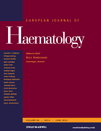Increased expression of APAF-1 in low-risk myelodysplastic syndrome: a possible role in the pathophysiology of myelodysplasia
Abstract
Objectives: APAF-1 is a central component of the intrinsic pathway of apoptosis, where APAF-1 dysregulation results in the development of diverse human neoplasms. The aim of this study was to characterize the mRNA expression levels of APAF-1 transcripts in low-risk and high-risk MDS and to elucidate whether the expression levels of APAF-1 transcripts are modulated with increased apoptosis in CD34+ MDS cells undergoing erythroid differentiation. Methods: APAF-1 (NM_181861) expression was verified, by quantitative RT-PCR, in bone marrow aspirates from 33 patients with myelodysplastic syndromes (MDS), at the time of diagnosis, and in erythroid differentiation cultures from CD34+ from normal donors and patients with MDS. Results: APAF-1 expression was significantly higher in low-risk, compared to high-risk MDS, according to IPSS (P < 0.0001), FAB (P = 0.0265), and cytogenetic risk (P = 0.0134). Low-risk MDS-derived differentiated erythroid cells demonstrated an increased expression of APAF-1, compared with normal cells, accompanied by an augmented rate of apoptosis. Conclusions: Increased expression of APAF-1 in low-risk disease and its positive correlation with the apoptotic rate observed during the erythroblast differentiation of low-risk MDS cells may indicate that the modulation of APAF-1, at the transcriptional level, participates in the pathophysiology of MDS.




